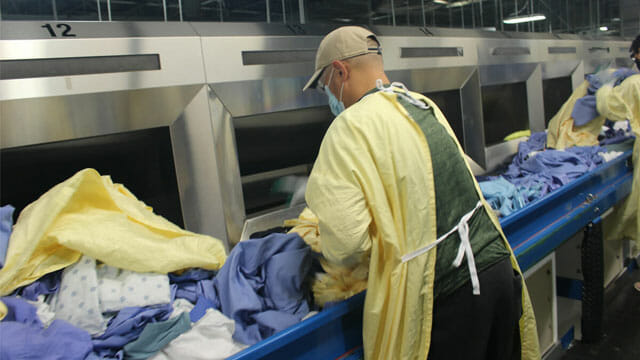‘Iso’ Gowns: Use of Reusables Grows During the Pandemic

The supply chain crisis that plagued hospitals seeking personal protective equipment (PPE) – particularly isolation gowns – early in the COVID-19 pandemic, has largely dissipated, according to laundry operators contacted recently by Textile Services Weekly. But while reusable “iso” gowns have helped to alleviate shortages facing hospitals needing up to 30 iso gowns a day for each COVID patient, a mix of reusable and disposable PPE appears to be the emerging model for many hospitals.
“Right now I would say most of them have some sort of hybrid system,” said Liz Remillong, vice president, strategic alliance, for Crothall Healthcare, a national chain with 29 facilities processing 600 million lbs. (272 million kg.) of healthcare textiles, including iso gowns, annually. “They’re not ready to give up on either completely. So they have both available for use.”
Remillong said that when the pandemic struck in March 2020, hospitals, which had largely relied on disposable iso gowns, scrambled to fill their needs with anything they could find, including reusable gowns. “We have a lot of facilities that went out and just bought reusables from anyone that said they could make them,” she said. As the supply situation has stabilized, laundry operators like Crothall have sought to convert hospitals to rental programs for reusable gowns that are more cost-effective than disposables and can offer a more a reliable supply chain since they often last for 100 washings or more. “Ultimately, in plants where we have a good rental pool, we’d like to convert them,” she said.
Another operator, Paul Jewison, vice president and general manager of Textile Care Services (TCS), Rochester, MN, says one large customer, the Mayo Clinic system, has made a significant move since the pandemic began to adopt reusable iso gowns, including both rental and customer-owned goods (COG) programs. “Almost all their facilities now have been converted to reusables,” he said of Mayo. “There’s still some spots that have disposable. The lion’s share of that they do now is reusable.”
Patrick Garcia, president of Division Laundry in San Antonio, says his team scrambled early on in the pandemic to find iso gowns for hospital clients. Division has specialized in locating and selling these reusable goods to hospital customers, mainly on a COG basis. Garcia mentioned a recent agreement with a large healthcare provider in Austin for which Division brokered the sale of 10,000 iso gowns. Division is now processing these garments on a COG basis. Another large system in San Antonio purchased several thousand reusable gowns that Division also is processing as COG items.
The pandemic situation in south Texas has deteriorated in recent weeks, and Garcia says he believes the hospitals bought the goods as a hedge against renewed shortages. “In my opinion, they were preparing for the worst time at the height of the pandemic,” he said. “They purchased these ahead of time, believing that the winter was going to be bad and that they want to demonstrate that they are prepared.”
Garcia added that in January, San Antonio schools issued a directive against in-class education that will keep students out of classrooms for several weeks. Hospitals also began deferring elective procedures due to a rising number of COVID-19 cases. “We’ve heard they’ve put elective surgeries on hold,” he says. “It hasn’t gotten a lot of media attention.” Garcia says the pandemic has hampered his production, with poundage down roughly 20% on an annual basis. Helping hospitals locate iso gowns has helped make up for some of that shortfall, while at the same time helping healthcare professionals protect staff and patients from the virus with a cost-effective solution to last year’s shortages.
As for whether laundry operators can convert healthcare providers to reusable iso gowns on a COG or rental basis for the long term, Remillong says the opportunity is there if laundry operators make their case to hospital executives. “I would say that they’re opening their minds to listen,” she says. “They don’t want to be the one having to buy product. They don’t want to have to keep track of inventory. They really only bought (iso gowns) out of necessity. For the most part isn’t anything that they want to be doing.”
